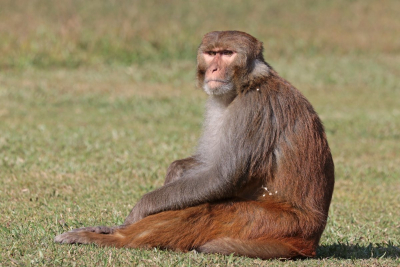Before humans went into space in the 1960s, several other animals were launched into space, including numerous other primates, so that scientists could investigate the biological effects of spaceflight. The United States launched flights containing primate passengers primarily between 1948 and 1961 with one flight in 1969 and one in 1985. France launched two monkey-carrying flights in 1967. The Soviet Union and Russia launched monkeys between 1983 and 1996. Most primates were anesthetized before lift-off.
Overall, thirty-two non-human primates flew in the space program; none flew more than once. Numerous backup primates also went through the programs but never flew. Monkeys and apes from several species were used, including rhesus macaque, crab-eating macaque, squirrel monkeys, pig-tailed macaques, and chimpanzees.
The rhesus macaque (Macaca mulatta), colloquially rhesus monkey, is a species of Old World monkey. There are between six and nine recognised subspecies that are split between two groups, the Chinese-derived and the Indian-derived. Generally brown or grey in colour, it is 47–53 cm (19–21 in) in length with a 20.7–22.9 cm (8.1–9.0 in) tail and weighs 5.3–7.7 kg (12–17 lb). It is native to South, Central, and Southeast Asia and has the widest geographic range of all non-human primates, occupying a great diversity of altitudes and a great variety of habitats, from grasslands to arid and forested areas, but also close to human settlements. Feral colonies are found in the United States, thought to be either released by humans or escapees after hurricanes destroyed zoo and wildlife park facilities.
The rhesus macaque is diurnal, arboreal, and terrestrial. It is mostly herbivorous, mainly eating fruit, but will also consume seeds, roots, buds, bark, and cereals. Studies show almost 100 different plant species in its diet. It will also eat invertebrates, drink water from streams and rivers, and has specialised cheek pouches where it can temporarily store food.
Like other macaques, the rhesus macaque is gregarious with troops comprising 20-200 individuals. The social groups are matrilineal, whereby a female's rank is decided by the rank of her mother. There has been extensive research into female philopatry, common in social animals, as females tend not to leave social group. It communicates with a variety of facial expressions, vocalisations, body postures, and gestures. Facial expressions are used to appease or redirect aggression, assert dominance, and threaten other individuals and vocalisations may be made to elicit grooming, while moving, or in threatening situations. It spends most of its day feeding and resting, the rest is occupied with travelling, grooming, and playing.
Due to its relatively easy upkeep, wide availability, and closeness to humans anatomically and physiologically, it has been used extensively in medical and biological research on human and animal health-related topics. It has facilitated many scientific breakthroughs including vaccines for rabies, smallpox, and polio and antiretroviral medication to treat HIV/AIDS. The rhesus macaque became the first primate astronaut in 1948, but died during the flight. It is listed as Least Concern in the IUCN Red List of Threatened Species in view of its wide distribution, presumed large population, and its tolerance of a broad range of habitats.

1949Jun, 14
Albert II, a rhesus monkey, rides a V-2 rocket to an altitude of 134 km (83 mi), thereby becoming the first monkey in space.
Choose Another Date
Events on 1949
- 1Apr
Communist Party of China
Chinese Civil War: The Chinese Communist Party holds unsuccessful peace talks with the Nationalist Party in Beijing, after three years of fighting. - 20Jul
1948 Arab-Israeli War
Israel and Syria sign a truce to end their nineteen-month war. - 1Oct
Mao Zedong
The People's Republic of China is established and declared by Mao Zedong. - 2Oct
Mao Zedong
The Soviet Union recognises the People's Republic of China, proclaimed the previous day by Mao Zedong. - 14Oct
People's Liberation Army
Chinese Civil War: Chinese Communist forces occupy Guangzhou.

 English
English  español
español  français
français  português
português  русский
русский  العربية
العربية  简体中文
简体中文 